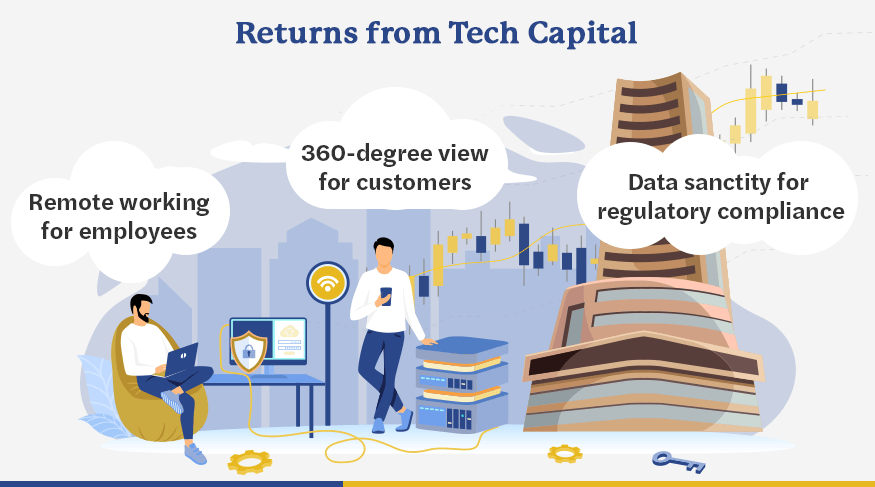Home » Industries » Capital Markets » Train data and cloud for a 360-degree view

Data and cloud are the two biggest moving pieces for capital market intermediaries such as investment banks, pension funds and credit unions. By getting on top of their data and cloud challenges, they can gain a 360-degree view of their customer’s risk profile and investment appetite, which then allows them to use tools like predictive analytics and pricing engines and make their deals profitable. In order to ensure that they don’t stumble, they also have to successfully meet reporting compliance requirements, a not inconsiderable feat with ever-tightening regulatory standards.
Facilitating all that is a diverse suite of capital market technology solutions in cloud platforms, data governance and analytics, and advanced CRM (customer relationship management) tools, much of which is based on artificial intelligence (AI) and machine-learning (ML) models. They must then be well-orchestrated to be in sync with stated goals. Firms that partner with technology providers who have a deep understanding and strong experience in their respective industry segments would clearly have an edge over others.
As capital market intermediaries grapple with those challenges, their starting point is usually data. In a typical capital market environment, companies receive data from multiple and diverse sources, and their biggest challenge is to create reservoirs of such data. So they build data lakes that different functions within their firm hydrate with their data.
They are investing also in so-called reference data platforms, a useful exercise for capital market firms since they collect large volumes of data. Much of that could be native, unstructured data that needs to be run past a data governance system before they can be structured and cleaned of errors. Here, AI and ML-based tools help weed out anomalies and ascertain the sanctity of the data, which can be testing challenges, especially with respect to regulatory compliance.
Surmounting the cloud barrier
Managing those gets easier with cloud platforms. Historically, many financial services firms have been fence-sitters in migrating their data and operations to the cloud, chiefly because of concerns over security. But the other shoe fell with the work-from-home model that COVID-19 brought, and it has forced them to make that cloud shift, and alongside, invest in data security measures to ward off potential risks. Cloud migration became a necessity, especially for large firms, because getting thousands of employees to go virtual at short notice would otherwise have been a humungous task.
Thankfully, for many capital market firms, that shift had no material impact on outcomes such as quality or productivity. This whole idea of remote working has been serendipitous for both organizations and employees. With cloud, you can now launch huge applications — even trading applications — on a browser. Technologies like containerization give you the same experience as if the application is sitting on a desktop (where applications using a common operating system are run in isolated user spaces called containers). With a robust cloud infrastructure, availability is not a challenge.
Coalesce for a 360-degree view
With their data in control and safe on the cloud, firms can coax their systems into allowing them a 360-degree view of their customers, complete with their historical perspectives, investment patterns, risk profiles and preferences. Machine learning helps them extrapolate this data and make better decisions. You take away human bias, effectively using data as a monetization channel.
Earlier, all those different facets of a customer’s profile would have been captured across disparate systems, but data science and cloud allow you to bring it all together, and, with CRM applications like Salesforce provide that 360-degree view to the end user, who could be a salesperson, a trader or a management executive.
Traders, for instance, could integrate their trading systems with risk platforms to get a unified view of customer risk profiles or buying history on a single screen, marshalling data and analytics that hitherto lay scattered across different systems and in structured or unstructured formats. Not surprisingly, this area is witnessing heightened interest and investment from financial services companies.
IT providers that draw their talent pools from within the capital markets to build delivery engines or execution engines for their capital market clients are well placed to respond to the emerging challenges. Possessing the right domain knowledge and intimate familiarity with the nuances of various industry segments are prerequisites to creating accelerators, or tools to enhance performance. Predictive analytics and conversational AI — such as chatbots that humans can converse with — are among the newer generation tools that technology partners typically build for their capital market clients.
Key takeaways
- Large volumes of data from disparate sources need effective data governance frameworks to make way for analytics and regulatory compliance for capital market intermediaries.
- The COVID-era work-from-home model has hastened cloud migration among capital market firms, along with the attendant investments in security infrastructure.
- Well-managed data systems, with cloud support, enable a 360-degree view of customer risk profiles and investment appetite, aided by predictive analytics.
Contact
Our experts can help you find the right solutions to meet your needs.
Get in touch
